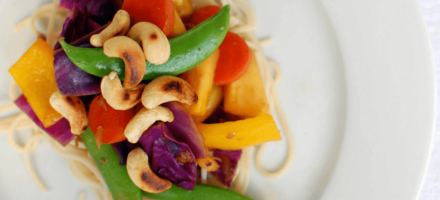
Pineapple Rainbow Stir Fry
My new Pineapple Rainbow Stir-Fry recipe is the perfect way to shake off any lingering winter sluggishness and give your ...
We’ve all experienced bloating. It appears as a swollen stomach or a feeling of fullness, which can occur immediately after eating or a few hours later. It’s usually caused by excess gas production and can be accompanied by abdominal pain [1].
If you’re often bloated, you’re not alone. About 16–30% of people report that they regularly experience a bloated belly [2]. It can be uncomfortable and frustrating, especially because it can occur after seemingly healthy meals.
This article looks at the foods which commonly cause bloating and why—and how you can tweak your diet to alleviate your symptoms.
Comprehensive list of foods that cause bloating
Foods that don’t cause bloating
Other bloating causes
Conclusion
References
The following foods and food groups are most likely to cause bloating
Let’s look at each in more detail.
‘FODMAP’ stands for:
Fermentable
Oligosaccharides
Disaccharides
Monosaccharides
And
Polyols
These are all types of natural sugars. They’re not absorbed in your small intestine, so they travel to your large intestine where they can be fermented by bacteria. This fermentation produces the gas that leaves you feeling bloated.
The tricky thing about FODMAPs is that many of the foods that contain them are healthy. These include:
– Onions and their partner in crime, garlic. Onions are one of the main dietary sources of fructans, a type of oligosaccharide [3]
– Legumes, such as beans and lentils. These are rich in galacto-oligosaccharides. Sprouting can make many beans and lentils more digestible. Black beans and green/brown lentils can be tolerated in small amounts too.
– Some fruit and vegetables including apples, asparagus, avocado, potato and mushrooms. These are high in a range of FODMAPs.
Removing high-FODMAP foods from the diet can provide some much-needed relief, alleviating bloating, pain and passage of wind [4]. But a low-FODMAP diet is not a permanent solution. This is because it reduces the amount of soluble fibre and prebiotics in the diet, which winds up reducing the number of friendly bacteria in your gut.
Alongside a low-FODMAP diet, it’s important to investigate underlying imbalances that can contribute to food intolerance, such as dysbiosis and small intestine bacterial overgrowth (SIBO) [5].
Lactose is a sugar that is found naturally in milk. It’s digested in the body by an enzyme called lactase.
In most people, lactase is only produced for the first few years of life. As far as evolution is concerned, we only need it while we are fed our mother’s milk—and most of the world’s population are lactose intolerant [6].
If you don’t have the lactase enzyme, you can’t digest lactose. Instead, it’s free to be fermented by gut bacteria—causing pain, diarrhoea, bloating and trapped wind.
Grains are common culprits when it comes to flatulence and bloating. The fibre in grains can be difficult to digest, and it often makes it to the large intestine intact—ready to be fermented by bacteria.
For people with coeliac disease or gluten sensitivity, wheat and other grains can cause major digestive problems due to their gluten content. Gluten can cause inflammation and intestinal permeability, leading to symptoms such as gas, diarrhoea, pain and a bloated stomach [7].
This family of vegetables includes broccoli, Brussels sprouts, cabbage, cauliflower, and kale as well as rocket, radishes, and watercress.
Cruciferous vegetables are generally very good for us, and especially for our liver. But they also contain a starch called raffinose (an oligosaccharide) that we don’t have the enzyme to digest [8]. This means raffinose passes into the large intestine undigested, leading to methane gas production and—you guessed it—bloating [9].
Cooking can increase the digestibility of cruciferous vegetables. Start with a small amount and see how you feel.
Sugar alcohols (xylitol, sorbitol and mannitol) are used to create sweetness in sugar-free foods and chewing gum. The problem is that your body can find artificial sweeteners difficult to digest (yet again due to those pesky FODMAPs), which increases the likelihood of gas, bloating and bowel problems.
Fructose is another simple sugar. It’s found in fruit (apples, grapes and watermelon), some vegetables (asparagus and courgettes), honey, agave nectar and many sweetened processed foods.
Special fructose carriers in the gut are responsible for fructose absorption. If you have a deficiency of these carriers, fructose can build up in your large intestine and cause gut issues, including bloating. Fructose malabsorption is fairly common, affecting up to one in three people [10].
As with many food intolerances, fructose malabsorption can also be down to a gut issue such as dysbiosis, inflammation or IBS.
The good news is that many delicious and healthy foods don’t cause bloating. If you’re experiencing symptoms such as a bloated stomach, upper stomach pain and trapped wind, these might be the ones to focus on for the moment—at least until any potential underlying issue is addressed.
Foods that don’t cause bloating or have “low-bloat potential” include:
Other than specific foods, it’s worth paying attention to these factors to reduce bloating:
If you do suffer from regular bloating, you may need to investigate the root cause of your ongoing symptoms. A comprehensive gut health test is often a good place to start.
Bloating can be caused by a number of seemingly healthy foods, including beans, vegetables, fruits, dairy and grains.
Reducing or eliminating these foods can help to alleviate symptoms, but an overly restrictive diet is not a long-term solution. Instead, it’s worth investigating the root cause of your bloating. Conditions often associated with bloating include IBS, SIBO and dysbiosis.
Author
Sophie Elletson (DipCNM) is a Registered Nutritional Therapist and editor. With a particular interest in female hormone health and gut health, she breaks down the research to help people to gain knowledge in an interesting and accessible way.
1. https://onlinelibrary.wiley.com/doi/full/10.1111/j.1365-2036.2007.03549.x
2. https://www.ncbi.nlm.nih.gov/pubmed/17931344
3. https://www.ncbi.nlm.nih.gov/pubmed/10395608
4. https://www.ncbi.nlm.nih.gov/pubmed/24076059
5. https://www.ncbi.nlm.nih.gov/pmc/articles/PMC2890937/
6. https://milk.procon.org/view.resource.php?resourceID=000661
7. https://www.ncbi.nlm.nih.gov/pubmed/24440147
8. https://pubchem.ncbi.nlm.nih.gov/compound/D-Raffinose#section=Top
9. https://www.ncbi.nlm.nih.gov/pubmed/20659225
10. https://www.foodintol.com/fructose-intolerance/fructose-malabsorption
11. https://www.ncbi.nlm.nih.gov/pubmed/21775556
12. https://www.ncbi.nlm.nih.gov/pubmed/19491831/
Back to top